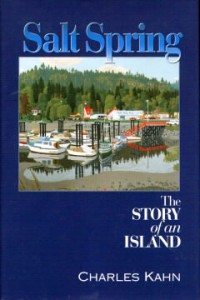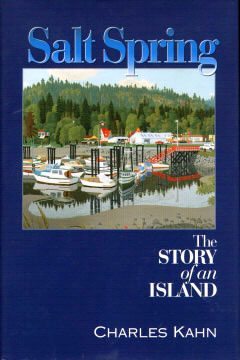
I was fortunate to go to the Salt Spring Historical Society presentation when Charles Kahn gave his talk about the history of Salt Spring. The talk is podcast below. It was a talk and slide show. Most of the slides are in his excellent Salt Spring history book which you can buy here.
This is out of the pamphlet published in 1902 by Edward Walter Sec’y Islands Farmers’ Institute, Ganges Harbour, BC.
Saltspring Island History – Admiral Island on the old Charts – in the province of British Columbia, in the Dominion of Canada, lying immediately south of the 49th parallel of north latitude, sheltered from the Pacific storms by the large island of Vancouver, and protected on th east by the many smaller isles which dot the surface of the Gulf of Georgia across to the mainland of the North American continent, is probably as regards position and climate themost favored of all the British Columbia islands.
In the centre of the triangle formed by the three chief ports of the Province – Victoria, Vancouver and Nanaimo- it is on the direct route of steamers plying between the capital, Victoria (pop. 21,000), and Nanaimo, the Coal city of the North Pacific (pop. 6,000), giving the Island daily connection with both places. It is about 50 miles by water from Victoria to Ganges Harbour, and rather less via the Victoria and Sidney railway; 26 from Nanaimo – both places on Vancouver Island – and 30 from Vancouver City (pop.26,000) on the mainland, the terminus of the Canadian Pacific railway.
The Island is about 17 miles in length from north to south, with an extreme width of nine miles, and contains roughly 45,000 acres, the greater part of which is mountainous, the highest point being 2,329 ft. above the sea.
The Climate is mild and very similar to that of the south of England. The temperature in summer seldom exceeds 86° F. in the shade and the nights are invariably cool. Cold weather for a week or so may be expected in November and January, when the temperature may fall to 20°, or once in ten years, perhaps, to within two or three degrees of zero. The average annual rainfall for the district is 39 in. The snowfall is light , and thunder storms very rare.
Dr. Gerald Baker, Ganges Harbour, says: “I consider the climate of Saltspring Island to be extremely healthy. Children thrive well, and we are particularly free from all zymotic diseases.”
Although the Island takes its name from salt springs found near the north end, there is an abundant supply of sweet water, good springs are plentiful and there are eleven lakes.
There are 100 occupied farms with settled population of 430.
There are several boarding houses and a general stores, two post offices (“Saltspring Island” and “South Saltspring Island”), and five public day schools.
The Rev. E.F. Wilson is the resident clergyman of the Church of England and has two churches, and there is a Roman Catholic and also a Methodist church.
There is a resident English doctor, and a telephone line extends over the greater part of the Island and is connected from Burgoyne Bay with the Victoria – Nanaimo line.
Generations of Alder and Maple have covered the valleys and bottom lands of Saltspring Island with a rich, black, leaf mould overlying a clay subsoil, which yields on cultivation heavy crops of hay, grain, and roots. But the higher lands and hill slopes, which nature has clothed chiefly with fir, cedar and balsam, and a undergrowth of the evergreen salal (gaultheria shallon) and bracken, have been found by experience to be the best position for orchards, and here, with a careful choice of aspect almost all kinds of fruit peculiar to temperate climates may be grown. Seen from a distance the island appears densely wooded to the mountain tops, but the timber thins as the elevation increases, giving space for grasses and many evergreen and deciduous shrubs. It is on the rocky, wooded heights that sheep thrive, secure from beasts of prey, sheltered from rain and wind by some thick branching fir, or basking on a ledge of lichen-covered rock. Here they find food the year round, but the careful shepherd will provide a box of salt and a rack of sweet hay in winter to which the sheep will come when snow threatens or feed is scarce.
Dairying, fruit growing, sheep raising for lamb and mutton, and poultry keeping are all carried on with profit, and a ready sale for first class produce is found in Victoria and Nanaimo.
Some prices of farm produce: Apples average 75 cents a box of 40 lbs., eggs 15 cents to 50 cents per doz., butter 20 cents to 35 cents per lb., lambs (live) $3.50 each, fowl (live) $6 per doz., Broilers (live) $4 per doz., ducks (live) $6 per doz. and pigs 7 cents per lb. live weight.
Freight to Victoria and Nanaimo $2.50 per ton, 25 cents for single packages and lambs (1 cent = 1/2 penny, $1 =4/2).
Prices of supplies: Flour $5 a bbl. of 200 lbs., sugar 6 cents per lb., wheat 11/2 cents per lb., potatoes $1 per 100lbs., meats 10 to 12 cents per lb.
The price of land varies with quality, situation, distance from a wharf, etc, Ranches of 100 to 160 acres are worth $1,000 to $5,000 (200 to 1000 pounds) according to amount of improvements, and a man should be able to make a living at once on a $5,000 farm.
Labourers and house servants are scarce.
The felling of timber on new land cost $6 to $8 per acre. This is done in winter and the trees being left to dry through the summer, a fire is run over them in the fall; the logs that remain being cut up, piled and burnt, the land is then seeded down to grass or broken up for a fist crop of potatoes.
A six-roomed cottage will cost from $400 and a cow $40.
There are many kinds of wild fruits; strawberries, blackberries, and cranberries being the most useful.
The chief exports besides agricultural products are pit props, cord-wood, charcoal, and sandstone.
Lovers of the Rod and Gun should find on Saltspring an attractive home, and from year’s end to year’s end ample occupation for leisure hours. From March to October the lakes which abound in trout, furnish excellent sport to fly fisher, their different altitudes extending the season well through the summer; as the higher lakes will often reward a visit when one might flog in vain the surface of those at lower level. The trout (salmon mykiss) are usually for 3/4 lb. to 11/4 lbs., but have been taken to much heavier weights.
With September the gun begins to take the place of the rod, and throughout the fall and winter months the rancher may well provide his larder with venison (black-tail deer, cariacus columbianus), blue and willow grouse, pheasant (introduced), snipe, and a varied assortment of waterfowl. And in the quiet pursuit of game, the hunter will meet with many lovely prospects, of purple hill a placid sea, of a distant jagged ridge of snow-capped mountains, or some giant peak, cone-shaped, solitary and glittering, above the blue haze of may miles of intervening forest; or, from a tall cliff look down over the needle tops of a sea of dark firs, flecked here and there with a golden maple, on some quiet lake set in green meadows and reddening orchards, with a curl of blue smoke rising from the hidden homestead.
The game laws of the province are stringent, and legislation tends towards preserving the game for the occupier of the soil.
The bays and inlets of the sea offer a safe boating, and a cruise among the many surrounding islands, making visits and fishing, and camping at night in some sheltered cove, is a most agreeable way of spending a week or two in the summer months. Salmon (July to November), sea trout (throughout the summer), and rock cod and ling (May to July) can be caught trolling with rod and spoon bait. Halibut, cod, and mackerel (so called), can be taken with bait from January to May in deep water, and flounders, herring and smelts are plentiful in season. Oysters are found in certain places, and clams everywhere along the shore.
The more adventurous need not, however, confine themselves to home waters, but can visit the neighboring Vancouver island, where elk (cervus canadensis) can still be found; or in a sloop or steam launch explore the sheltered waterways north even to Alaska, and visit the many inlets on the mainland coast in search of bear and mountain goat, or to prospect for minerals. And although the sportsman will find on Saltspring Island such scenes and pursuits as should be dear to all lover of nature, he need not cut himself and family adrift from the comforts and conveniences of modern civilisation, nor from social intercourse; and those looking for a home will appreciate the Island’s freedom from beasts of prey, poisonous snakes, malaria, and last but not least, from mosquitoes.
By F.M Philips 1902
Cheers,
Scott & June Simmons
The Salt Spring Team

